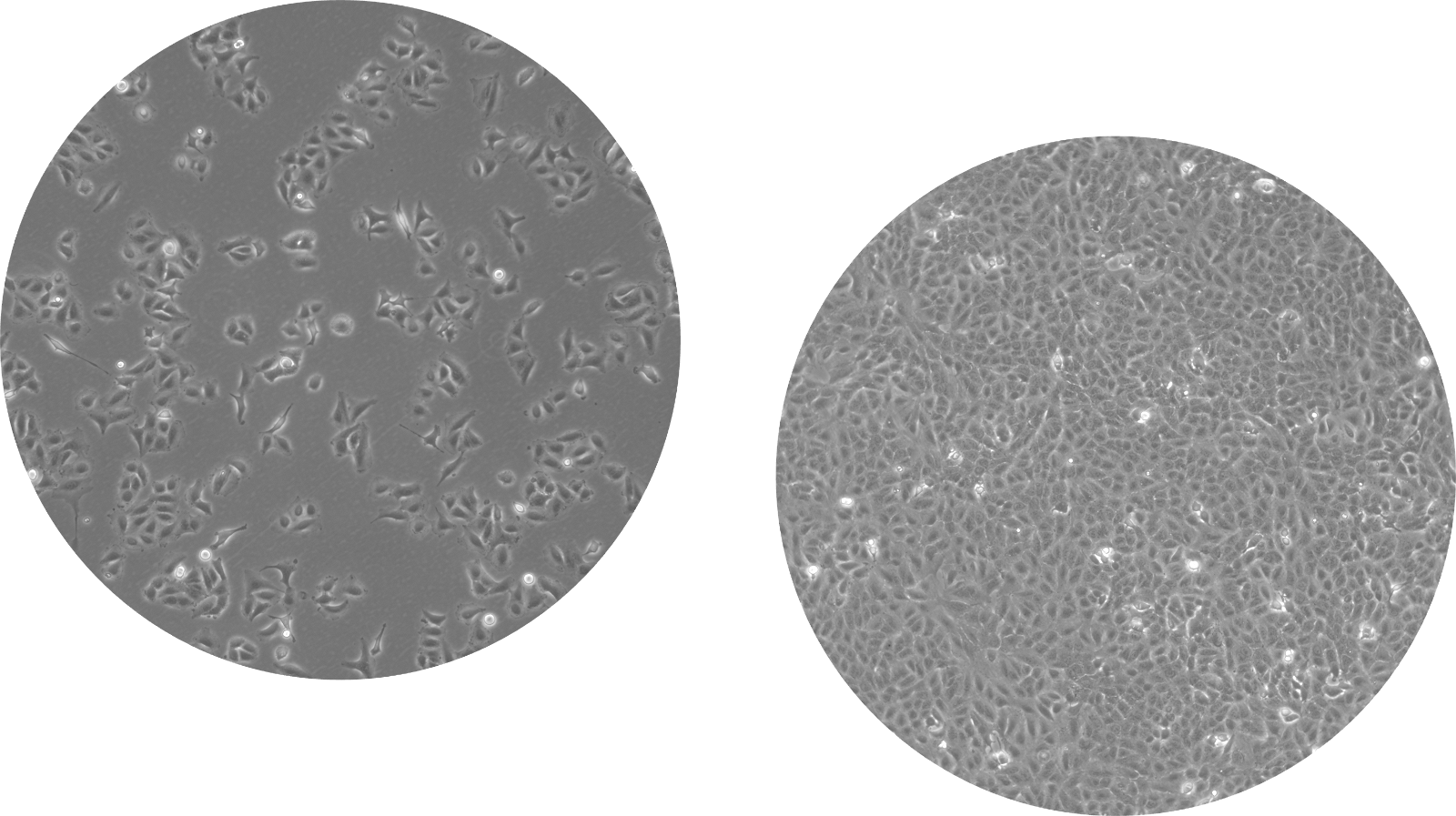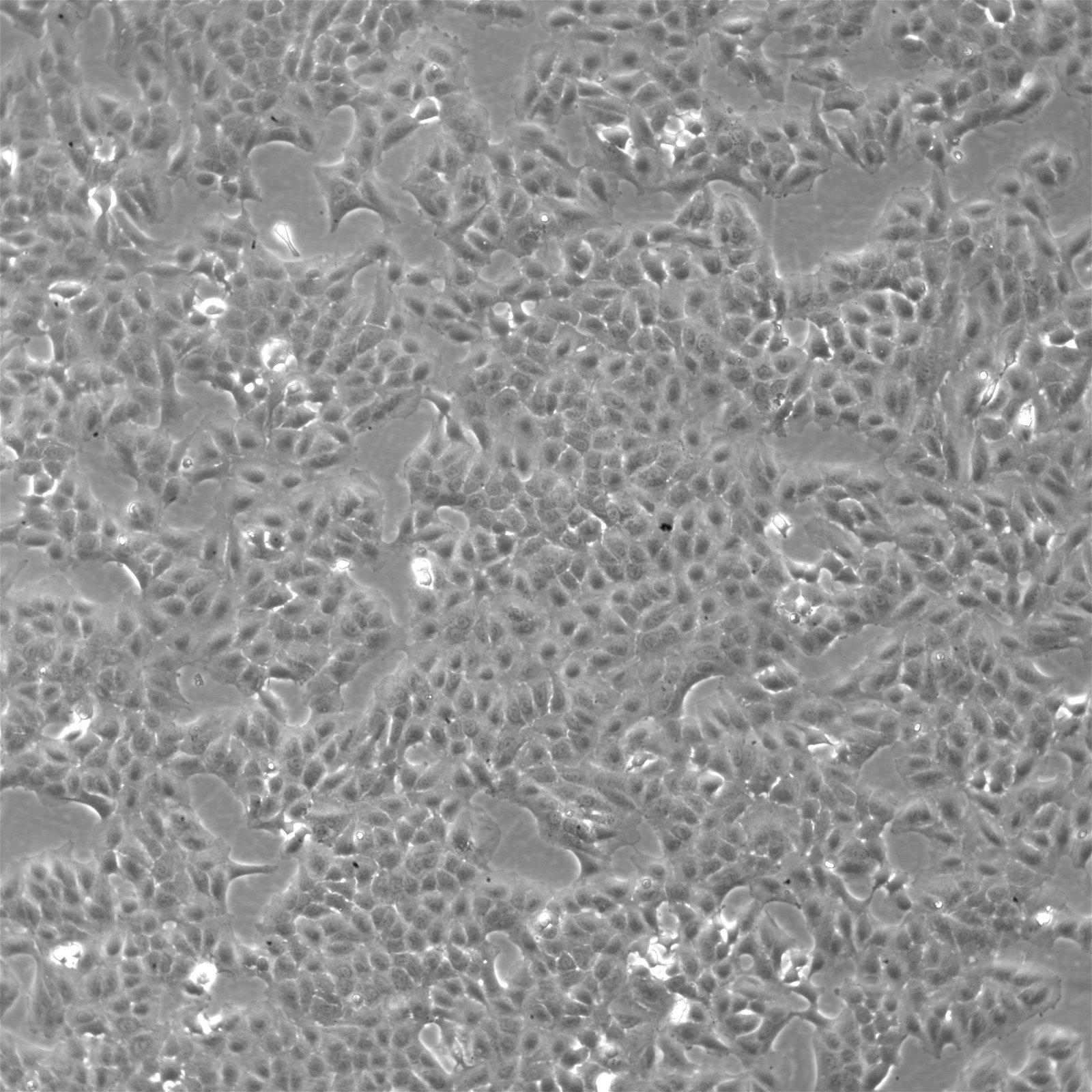A549 Cell Line: A Keystone in Lung Cancer Research
The A549 cell line, emblematic of human non-small cell lung cancer, originates from the adenocarcinoma subtype within the alveolar epithelial cells. These cells offer a versatile model for a wide array of investigations in cancer biology, toxicology, and immuno-oncology. This article aims to furnish a detailed overview of A549 cells, covering their origin, inherent characteristics, and pivotal role in scientific research, thereby equipping researchers with the knowledge to effectively employ this cell line in various study domains.
A549 Origins and Cellular Profile
First isolated in 1972 from the lung cancer tissue of a 58-year-old Caucasian male, the A549 cancer cell line was established by D. J. Giard and associates. They are characterized by an adherent growth pattern, forming monolayers with an epithelial-like morphology reminiscent of squamous lung tissue cells. The typical cell diameter for A549 ranges between 10 µm and 15 µm. Notably, the A549 cell line displays a hypotriploid chromosome count, deviating from the normal human cell complement. The modal chromosome number in approximately 24% of cells is 66, with occasional cells (0.4%) exhibiting 64 or 67 chromosomes, indicative of their genomic instability.
Research Applications of A549 Cells
A549 cells have become indispensable in molecular biology and therapeutic research, particularly in the development of adenoviral vectors for gene therapy and vaccine applications. Their capability to support adenovirus production without the need for the E1A oncogene makes them an ideal model for studying adenoviral gene expression and replication. This feature is particularly crucial in the context of adenoviral-based therapeutic and vaccine strategies undergoing clinical trials. Moreover, A549 cells are frequently employed as a control in assays to assess the replication competency of E1A-deficient adenoviral constructs, highlighting their broad applicability in advancing clinical research.
Production of Adenovirus
A549 is a viable source for producing adenoviruses, as these viral constructs do not require additional viral oncogenes (E1A or early region 1A) for the transcription of the viral gene. Adenoviral-based therapies and vaccine strategies use these constructs in clinical trials. Additionally, the A549 cell line is used in assays as a control to measure the replication of adenovirus constructs deficient in the E1A gene [1].
Drug Screening and Development
The A549 cell line is a valuable model for drug screening, as demonstrated in recent research. For example, in 2021, a study used A549 cells to screen 65 plants collected from Western Andalusia, Spain for selective anticancer activity [2]. Additionally, another study explored the anti-cancer potential of green nanoparticles using the A549 cell line [3].
A549 as a Disease Model
Due to their origin, the A549 lung carcinoma-derived epithelial cells have become a popular disease model for lung cancer research [4]. For instance, a recent study employed A549 cells to develop a cell line-based xenograft model of lung carcinoma for investigating tumor growth and metastasis [5]. Additionally, the A549 cell line is a reliable mimic of type II alveolar epithelium [6]. This makes it a valuable tool for studying metabolic processes in lung tissue and investigating drug delivery to the pulmonary tissue.

Subconfluent (left) and confluent (right) A549 cells cultured by Cytion
A549: Cell Growth and Cell Cycle Regulation
A549 cell growth is a key area of study, especially in understanding how these cells progress through the cell cycle. The investigation into cell cycle genes and the impact of cell cycle inhibitors on A549 cells provides insights into the mechanisms of cancer cell proliferation. Techniques like cell sorting and the formation of cell pellets are essential in these studies, allowing researchers to isolate and analyze specific cell populations. Electron microscopy offers detailed imagery, further elucidating the cellular structures and processes at play.
Alternative Tissue Culture Models and Gene Expression Studies
As an alternative tissue culture model, A549 cells mimic the ATII cell phenotype, displaying ATII differentiation characteristics. This makes them particularly useful for studying human ATII cells and surfactant protein genes. Advanced techniques such as microarray gene expression and RNA expression ATP analyses facilitate comprehensive comparisons of gene expression between A549 cells and primary human lung cells, including endothelial cells. These comparisons are crucial for understanding cancer at a molecular level and for developing targeted therapies.
Chemotherapy Resistance and Treatment Efficacy
The role of A549 cells in NSCLC chemotherapy resistance research is notable, especially concerning drugs like cisplatin and pemetrexed. Studies often focus on the mechanisms behind chemotherapy resistance, with a particular interest in cassette lipid transporters and the impact of genetic factors on drug efficacy. The efficacy of alternative treatments, such as glutathione esters and the potential use of botulinum neurotoxin mechanisms, is also explored within this context.
A549 Cell Line Cultivation Guide
This section consolidates essential cultivation parameters and practices for the A549 cell line, providing a comprehensive resource for optimal culture conditions. It covers key aspects such as population doubling time, adherence properties, optimal seeding densities, preferred growth media compositions, and standard culturing environments.
Cultivation Parameters
Population Doubling Time: Approximately 28 hours, indicating the time required for the cell population to double in number.
Adherence Characteristics: A549 is an adherent cell line, forming monolayers, which facilitates direct observation and manipulation.
Seeding Density: An initial seeding density of 1 x 10^4 cells/cm^2 is recommended to ensure optimal growth conditions and cell confluency.
Growth Medium: A nourishing blend of either DMEM or Ham's F12 medium, enriched with 5% Fetal Bovine Serum (FBS) and supplemented with L-glutamine, supports robust cell growth.
Culturing Conditions: Cultures thrive in a humidified atmosphere at 37°C, with a 5% CO2 balance, mimicking physiological conditions.
Storage Protocol: Cells are best preserved in the vapour phase of liquid nitrogen, ensuring long-term viability.
Cryopreservation and Recovery: Employing a controlled-rate freezing method with CM-ACF or CM-1 media safeguards cellular integrity during cryopreservation. Thawing involves rapid warming in a 37°C water bath, followed by centrifugation to remove cryoprotectant, and resuspension in fresh growth media.
Biosafety and Contamination Control
Biosafety Classification: Classified under Biosafety Level 1, A549 cells require standard microbiological practices to ensure safe handling.
Contamination Mitigation: While A549 cells, like other cultures, are prone to microbial contamination, adherence to strict aseptic techniques minimizes this risk. Changes in medium pH and turbidity can indicate bacterial presence, whereas mycoplasma infections, more insidious, necessitate regular testing due to their potential to compromise cellular physiology and experimental outcomes.
Unlock the potential of your research with our high-quality A549 cells
Advantages and Considerations in A549 Cell Line Utilization
The A549 cell line stands as a prominent model in lung cancer research, favored for its well-documented biological behavior and straightforward culturing requirements. However, vigilance against microbial contamination is paramount, as is the case with any in vitro model. Specifically, the risk of mycoplasma infection underscores the need for regular diagnostic screening. Furthermore, to maintain cellular integrity and reproducibility in experimental results, it is advisable to limit A549 cultures to a maximum of 20 passages.
A549 cells: Research Publications
In this section, you can explore a selection of notable publications on A549 lung carcinoma cells that may inspire new research ideas involving this cell line.
- A study conducted in 2020 aimed to develop suspension cultures of A549 cells to enhance the production of oncolytic adenoviruses, which are used for cancer therapy.
- This study used the A549 cell line to evaluate the anti-cancer potential of Hypnea valentiae seaweed-loaded green nanoparticles.
- This publication in the Bioengineered journal proposes C-met specific chimeric antigen receptor T cell as direct therapy for A549 non-small cell lung carcinoma cells.
- A549 cells were used for anti-cancer drug screening, specifically the role of gallic acid, a natural compound, in inducing cell death and preventing lung cancer progression.
- This research paper utilized the A549 cell line to validate the anti-tumor activity of combined paclitaxel and curcumin compound nanoformulations.
- This publication in the Cancer Management and Research journal employed A549 cells as a non-small lung cancer model and study the mechanism behind cisplatin resistance.
- This study explored the varying effect of human adenovirus early region (E1A) protein isoforms on aerobic glycolysis by using the A549 cell line as a cell model.
Resources for the A549 cell line
The A549 cell line, recognized for its origin from lung carcinoma epithelial cells, is extensively documented within the scientific community. A wealth of information is available, encompassing detailed protocols for culturing, transfection techniques, and other critical experimental procedures, making it a valuable resource for researchers in the field of cancer biology and related disciplines.
A549: Transfection protocols
Transfection protocol: This site provides all necessary information for transfecting A549 cells.
Transfection of A549 cells: This link will lead to a DNA transfection protocol for the A549 cell line.
Transfection protocol: A general DNA transfection protocol for mammalian cell lines is shown in this video.
Videos about the A549 cell line
Cell culture protocol for A549 cells: This video is about culturing the human lung carcinoma cell line A549.
A549 general information: This video provides some basic information about the A549 cell line.
A549 Cells FAQ
With this comprehensive guide to the A549 cell line, you have all the necessary information to use this powerful tool in your research. Whether you're exploring cancer, toxicology, or immuno-oncology, A549 cells offer a reliable and well-characterized model. If you're ready to get started, don't hesitate to reach out to us or order from our website today. We can't wait to see the groundbreaking discoveries that you'll uncover with A549 cells.
References
- Moreira, A.S., et al., Establishing suspension cell cultures for improved manufacturing of oncolytic adenovirus. Biotechnology Journal, 2020, 15(4): p. 1900411.
- Calderón-Montaño, J.M., et al., Screening for selective anticancer activity of 65 extracts of plants collected in Western Andalusia, Spain. Plants, 2021, 10(10): p. 2193.
- Viswanathan, S., et al., Anti-cancer activity of Hypnea valentiae seaweed-loaded gold nanoparticles through the EMT signaling pathway in A549 cells. Biochemical Systematics and Ecology, 2023, 107, p. 104606.
- Garcia-de-Alba, C., Repurposing A549 adenocarcinoma cells: New options for drug discovery. 2021, American Thoracic Society, p. 405–406.
- Qi, L., et al., In vivo tumor growth and spontaneous metastasis assays using A549 lung cancer cells. Bio-protocol, 2020. 10(7): p. e3579-e3579.
- Khan, P., et al., Culture of human alveolar epithelial type II cells by sprouting. Respiratory research, 2018. 19(1): p. 1-7.

